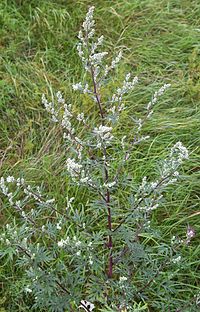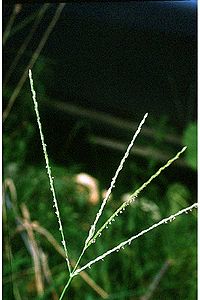Bloom Clock/Keys/Global/Temperate/Mid Summer/Green Flowers
Acalypha rhomboidea

This page is part of the global dichotomous key for plants recorded as blooming in Mid Summer.
These plants have the following traits:
- Green flowers
 Wikipedia • Commons • Wikibooks (horticulture) • Wikibooks (subject) • Wikispecies • Fruit and seed clock |
Profile for Acalypha rhomboidea (Common Three-seeded mercury)
Recent Logsedit | ||||||||||
Global data:
Temperate zone season(s): Mid Summer, Late Summer, Early Fall
Alchemilla mollis
 Wikipedia • Commons • Wikibooks (horticulture) • Wikibooks (subject) • Wikispecies • Fruit and seed clock |
Profile for Alchemilla mollis (Lady's Mantle)
Recent Logsedit | ||
Global data:
Temperate zone season(s): Late Spring, Early Summer, Mid Summer
Amaranthus blitoides
 Wikipedia • Commons • Wikibooks (horticulture) • Wikibooks (subject) • Wikispecies • Fruit and seed clock |
Profile for Amaranthus blitoides (Prostrate Pigweed)
Recent Logsedit
| ||
Global data:
Temperate zone season(s): Early Summer, Mid Summer
Amaranthus retroflexus
 Wikipedia • Commons • Wikibooks (horticulture) • Wikibooks (subject) • Wikispecies • Fruit and seed clock |
Profile for Amaranthus retroflexus (Redroot pigweed)
Recent Logsedit | ||
Global data:
Ambrosia artemisiifolia
 Wikipedia • Commons • Wikibooks (horticulture) • Wikibooks (subject) • Wikispecies • Fruit and seed clock |
Profile for Ambrosia artemisiifolia (Common Ragweed)
Recent Logsedit | ||||||||
Global data:
Temperate zone season(s): Mid Summer, Late Summer bcpgt/9
| Higher taxa = | Cookbook link = | General information = | version tracking for top template (for robotic use) = 8.4.25 }}
Ambrosia trifida
 Wikipedia • Commons • Wikibooks (horticulture) • Wikibooks (subject) • Wikispecies • Fruit and seed clock |
Profile for Ambrosia trifida (Giant Ragweed)
Recent Logsedit | ||||||||
Global data:
Artemisia vulgaris
 Wikipedia • Commons • Wikibooks (horticulture) • Wikibooks (subject) • Wikispecies • Fruit and seed clock |
Profile for Artemisia vulgaris (Mugwort)
This page contains recent bloom logs for the plant Artemisia vulgaris (Mugwort). If you saw this plant blooming today (or sometime within the last 3 days), you can help improve the bloom clock by logging it. Just click on "edit" next to the Recent Logs heading, add *~~~~ (an asterisk followed by four tildes) on a new line just below the last signature, and then click "save page". This will add your signature and the date to log the plant. Please make sure you've signed up on the contributors' page so that we can know the location of the plant you saw blooming and use your contribution to create a flora for your region! When you're done, you can go back to one of the main pages and find logs of other flowers you might have seen today.
Recent Logsedit
Archived Logsedit(If there are more than 5 signatures under the recent logs heading, move the oldest logs to under this heading (generally leave the 3 most recent).
| ||
Global data:
Chenopodium album
 Wikipedia • Commons • Wikibooks (horticulture) • Wikibooks (subject) • Wikispecies • Fruit and seed clock |
Profile for Chenopodium album (Lambsquarters, Goosefoot)
Recent Logsedit
| ||||||||
Global data:
Temperate zone season(s): Mid Summer, Late Summer, Early Fall, Mid Fall, Late Fall
Digitaria
 Wikipedia • Commons • Wikibooks (horticulture) • Wikibooks (subject) • Wikispecies • Fruit and seed clock |
Profile for Digitaria (Crabgrass)
Recent Logsedit | ||
Global data:
Mollugo verticillata
 Wikipedia • Commons • Wikibooks (horticulture) • Wikibooks (subject) • Wikispecies • Fruit and seed clock |
Profile for Mollugo verticillata (Carpetweed)
Recent Logsedit
| ||||||||||||
Global data:
Temperate zone season(s): Early Summer, Mid Summer, Late Summer, Early Fall, Mid Fall
Nicotiana langsdorffii
 Wikipedia • Commons • Wikibooks (horticulture) • Wikibooks (subject) • Wikispecies • Fruit and seed clock |
Profile for Nicotiana langsdorfii (Green flowering tobacco)
Recent Logsedit
| ||
Global data:
Plantago major
 Wikipedia • Commons • Wikibooks (horticulture) • Wikibooks (subject) • Wikispecies • Fruit and seed clock |
Profile for Plantago major (Broadleaf Plantain)
Recent Logsedit
| ||||||||||
Global data:
Temperate zone season(s): Early Summer, Mid Summer, Late Summer
Setaria
 Wikipedia • Commons • Wikibooks (horticulture) • Wikibooks (subject) • Wikispecies • Fruit and seed clock |
Profile for Setaria (Foxtail)
Recent Logsedit | ||
Global data:
Sicyos angulatus
 Wikipedia • Commons • Wikibooks (horticulture) • Wikibooks (subject) • Wikispecies • Fruit and seed clock |
Profile for Sicyos angulatus (Bur Cucumber)
Recent Logsedit | ||||||
Global data:
